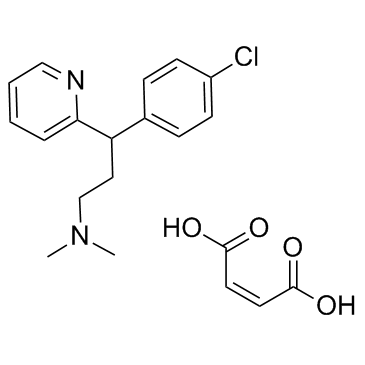Chlorpheniramine maleate

Chlorpheniramine maleate structure
|
Common Name | Chlorpheniramine maleate | ||
|---|---|---|---|---|
| CAS Number | 113-92-8 | Molecular Weight | 390.861 | |
| Density | 1.1±0.1 g/cm3 | Boiling Point | 379.0±42.0 °C at 760 mmHg | |
| Molecular Formula | C20H23ClN2O4 | Melting Point | 130-135 °C(lit.) | |
| MSDS | Chinese USA | Flash Point | 183.0±27.9 °C | |
| Symbol |

GHS07 |
Signal Word | Warning | |
|
Evaluation of Chlorpheniramine Maleate microparticles in orally disintegrating film and orally disintegrating tablet for pediatrics.
Drug Dev. Ind. Pharm. 40(7) , 910-8, (2014) To mask the bitterness of Chlorpheniramine Maleate via encapsulating drug into Eudragit EPO microparticles, and then incorporate these microparticles into orally disintegrating films (ODF) and orally disintegrating tablets (ODT) for pediatric uses.Spray dryin... |
|
|
Magnetic solid phase extraction coupled with desorption corona beam ionization-mass spectrometry for rapid analysis of antidepressants in human body fluids.
Analyst 140 , 5662-70, (2015) Ambient ionization techniques show good potential in rapid analysis of target compounds. However, a direct application of these ambient ionization techniques for the determination of analytes in a complex matrix is difficult due to the matrix interference and... |
|
|
Developing structure-activity relationships for the prediction of hepatotoxicity.
Chem. Res. Toxicol. 23 , 1215-22, (2010) Drug-induced liver injury is a major issue of concern and has led to the withdrawal of a significant number of marketed drugs. An understanding of structure-activity relationships (SARs) of chemicals can make a significant contribution to the identification o... |
|
|
A predictive ligand-based Bayesian model for human drug-induced liver injury.
Drug Metab. Dispos. 38 , 2302-8, (2010) Drug-induced liver injury (DILI) is one of the most important reasons for drug development failure at both preapproval and postapproval stages. There has been increased interest in developing predictive in vivo, in vitro, and in silico models to identify comp... |
|
|
Chemical genetics reveals a complex functional ground state of neural stem cells.
Nat. Chem. Biol. 3(5) , 268-273, (2007) The identification of self-renewing and multipotent neural stem cells (NSCs) in the mammalian brain holds promise for the treatment of neurological diseases and has yielded new insight into brain cancer. However, the complete repertoire of signaling pathways ... |
|
|
Genetic mapping of targets mediating differential chemical phenotypes in Plasmodium falciparum.
Nat. Chem. Biol. 5 , 765-71, (2009) Studies of gene function and molecular mechanisms in Plasmodium falciparum are hampered by difficulties in characterizing and measuring phenotypic differences between individual parasites. We screened seven parasite lines for differences in responses to 1,279... |
|
|
Characterization of the commercially-available fluorescent chloroquine-BODIPY conjugate, LynxTag-CQGREEN, as a marker for chloroquine resistance and uptake in a 96-well plate assay.
PLoS ONE 9(10) , e110800, (2014) Chloroquine was a cheap, extremely effective drug against Plasmodium falciparum until resistance arose. One approach to reversing resistance is the inhibition of chloroquine efflux from its site of action, the parasite digestive vacuole. Chloroquine accumulat... |
|
|
Differential thermodynamic driving force of first- and second-generation antihistamines to determine their binding affinity for human H1 receptors.
Biochem. Pharmacol. 91(2) , 231-41, (2014) Differential binding sites for first- and second-generation antihistamines were indicated on the basis of the crystal structure of human histamine H1 receptors. In this study, we evaluated differences between the thermodynamic driving forces of first- and sec... |
|
|
Severe anaphylactic reaction after intracameral antibiotic administration during cataract surgery.
J. Cataract Refract. Surg. 31(3) , 620-1, (2005) We report a severe anaphylactic reaction that occurred about 5 minutes after 1.0 mg of cefuroxime was injected into the anterior chamber after routine phacoemulsification and intraocular lens implantation. The patient was known to be allergic to penicillin. I... |
|
|
Aseptic meningitis associated with intravenous administration of dexchlorpheniramine.
Ann. Med. Interne (Paris.) 154(3) , 179-80, (2003) Drug-induced aseptic meningitis has been reported mainly with the use of nonsteroidal anti-inflammatory drugs, antibiotics, intravenous immunoglobulins and OKT3 antibodies. We describe today a very unusual reaction on intravenous dexchlorpheniramine with this... |